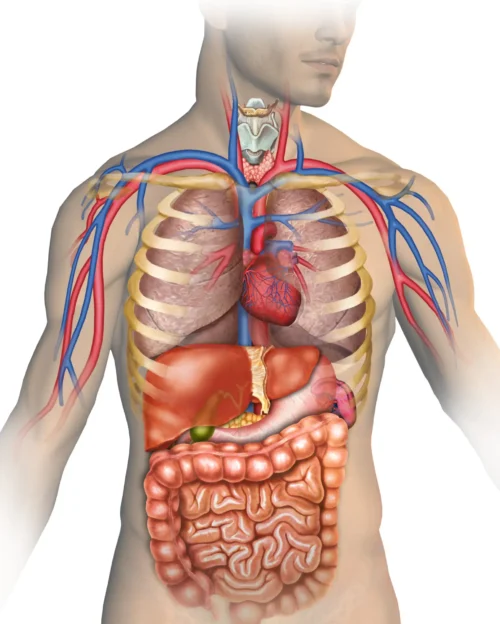Anatomy

Table of Contents
What is Anatomy?
Anatomy refers to the study of the structure and organization of living organisms. It involves examining and analyzing the physical components and internal structures of organisms, including humans and other animals, plants, and even microscopic entities. The field of anatomy aims to understand the relationships between different body parts and how they function together to sustain life.
Aspects of Anatomy
Macroscopic (Gross Anatomy)
Macroscopic anatomy, also known as gross anatomy, is the branch of anatomy that deals with the study of an organism’s structural features that are visible to the naked eye. This field does not require microscopic examination, as it involves observing and analyzing larger structures within the body.
Study of Visible Structures: Macroscopic anatomy involves examining body parts that can be seen without magnification. This includes organs like the heart, lungs, liver, and brain and larger structures such as bones, muscles, and blood vessels.
Focus on Organs and Tissues: The discipline often focuses on how organs and tissues are organized and interconnected within various body systems. It looks at how these components function together to support the organism’s life processes.
Organ Systems: Macroscopic anatomy examines the body’s organ systems, such as the skeletal, muscular, circulatory, digestive, respiratory, urinary, nervous, endocrine, immune, and reproductive systems. It explores the physical relationships and interactions between these systems that enable complex biological functions.
Microscopic Anatomy
Microscopic anatomy, unlike macroscopic anatomy, delves into the study of structures that are too small to be seen with the naked eye and thus require magnification tools like microscopes. This branch of anatomy provides insight into the intricate details of organisms at the cellular and tissue levels.
Histology: This is the study of tissues, which are groups of similar cells that perform specific functions. Histologists examine how cells organize into tissues and how these tissues form organs and systems within the body. Histology helps understand the structure and function of various tissues, including muscle, connective, nervous, and epithelial tissues.
Cytology: Cytology focuses on studying individual cells, their components, and their functions. It involves analyzing the cell’s life cycle, including division, metabolism, and death, and understanding how cells interact with their environment. Cytology is fundamental in identifying cellular abnormalities that lead to diseases such as cancer.
Comparative Anatomy
This scientific discipline is pivotal in revealing how various organisms have evolved and how similar anatomical features have adapted to different environmental and functional demands across species.
- Evolutionary Relationships: Through the comparison of physical structures, comparative anatomy helps to trace the evolutionary lineage of organisms, illustrating how different species are related to each other and their common ancestors.
- Adaptations and Divergence: The study also focuses on how anatomical features have changed to suit specific needs. For instance, examining limb structures across various animals can demonstrate how these limbs have evolved for functions like grasping, walking, or swimming, reflecting adaptive radiation.
- Homologous and Analogous Structures: Comparative anatomy distinguishes between homologous structures, which are derived from a common ancestor but may serve different functions (indicating divergent evolution), and analogous structures, which serve similar functions but are not derived from a common ancestor (indicating convergent evolution).
- Phylogenetics: The discipline contributes to phylogenetics, the study of the evolutionary history and relationships among species. By comparing anatomical structures, scientists can construct phylogenetic trees that hypothesize relationships among species, visually representing these relationships.
Additional Anatomy Fields
These subfields of anatomy each focus on different aspects of the body’s structure and function, providing comprehensive insights into how organisms are built and operate:
Developmental: This branch studies the changes in an organism’s structure from the earliest stages of development, starting with fertilization, through embryonic and fetal development, to birth and into adulthood. It helps in understanding how genetic and environmental factors influence the growth and formation of anatomical structures.
Functional: Concentrates on the connections between the structure of an organ or body part and its function, exploring how anatomical features are adapted for specific physiological roles. This field is crucial for understanding how different parts of the body work and interact to maintain homeostasis and respond to challenges.
Systemic: This area examines the body’s organ systems, looking at how groups of organs work together to perform complex functions. For example, studying the digestive system would involve examining the mouth, esophagus, stomach, intestines, and accessory organs like the liver and pancreas.
Regional: Focuses on specific areas or regions of the body, integrating the various anatomical structures within that region, such as bones, muscles, nerves, and vessels. This approach is particularly useful in medical education and surgical practice.
Surface: Involves the study of external anatomical features and their relationship to deeper structures. It is vital for clinical practice, allowing healthcare professionals to identify and palpate landmarks on the body to diagnose conditions or administer treatments.
Radiological: Utilizes imaging technologies to view and analyze the body’s internal structures. This field is essential in modern medicine, providing non-invasive methods to observe and assess health conditions and guide interventions.
Clinical: Applies the principles and knowledge of anatomy directly to clinical practice, bridging the gap between anatomical science and medical treatment. It encompasses understanding the anatomical basis of disease, surgical procedures, and diagnostic methods.
Related Links
Microscope
Botany
Fertilization
The Nervous System